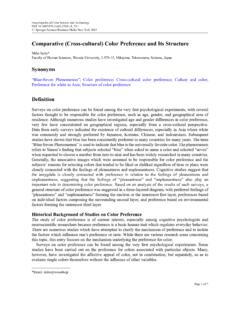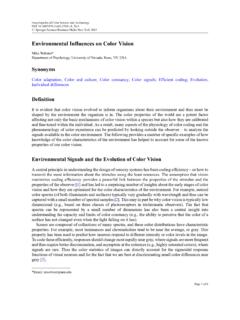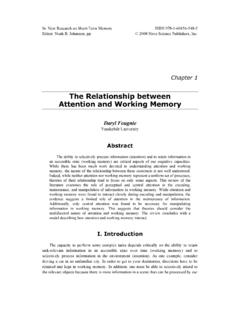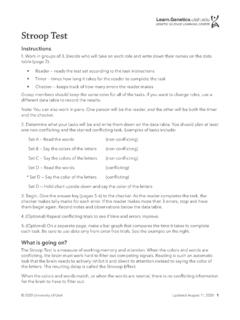Transcription of The Stroop Effect - IMBS
1 The Stroop EffectColin M. MacLeod*Department of Psychology, University of Waterloo, Waterloo, ON, CanadaSynonymsColor-word interference; Stroop interferenceDefinitionThe Stroop Effect is one of the best known phenomena in all of cognitive science and indeed inpsychology more broadly. It is also one of the most long standing, having been reported by John RidleyStroop in the published version of his dissertation in 1935 [1]. In its basic form, the task is to name thecolor in which a word is printed, ignoring the word itself. When the word is a color word printed in amismatched ink color, this is very difficult to do and results in slow, error-prone responding.
2 To illustrate,considerGREEN: To say red to the ink color is difficult relative to a variety of comparison or controlconditions such as naming the color ofXXXXXor the wordTABLEor even the cost in the mismatch condition usually referred to as the incongruent condition relativeto the controls is called the Stroop Effect or Stroop interference. Figure1provides an illustration ofthe the very beginning of experimental psychology, it has been clear that words are faster to read thanobjects or their properties are to name. In his dissertation in 1886, Cattell [2] even went so far as to suggestthat word reading is automatic due to extensive practice, introducing the concept of automaticity tocognitive science.
3 Automatic processes can be thought of as unintentional, uncontrolled, unconscious,and fast [3]. Under the automaticity account, people cannot comply with an instruction not to read becausereading cannot be turned off ; hence it is guaranteed that incompatible words will cause interferencewhen attempting to name their print early on, the other prevalent explanation of Stroop interference was the relative speed ofprocessing account, which in its simplest form argued that faster processes can affect slower processesbut not vice versa [4]. Thus, because words are read faster than colors can be named, interference resultswhen the task is to name the colors and ignore the words.
4 This alsofits nicely with Stroop s otherfinding that there was no reverse Stroop interference when the task was to read the words and ignorethe colors: Reading performance for incongruently colored words was equivalent to that for words printedin standard black ink. Stroop s results are highly replicable, as MacLeod [5] showed over a halfcentury Stroop s landmark study, many hundreds of studies have sought to understand this superficiallysimple phenomenon, and many more have used his method to explore key aspects of attention, learning,memory, reading, language, and other cognitive skills [5].
5 More recently, the Stroop task has also been*Email: of Color Science and TechnologyDOI #Springer Science+Business Media New York 2015 Page 1 of 6extended to investigate neural mechanisms [6] and clinical disorders [7], among other issues. Interest inStroop s method shows no signs of abating; indeed, it is one of the rare phenomena/tasks where interestseems to be growing rather than diminishing with the passage of Gradient of InterferenceAn intriguing feature of the Stroop literature, though, is that there was virtually no follow-up to his workfor about 30 years; it is only in the 1960s that research on this phenomenon resumed and then with avengeance.
6 The simplest explanation of this is that the advent of computer-controlled experiments, andespecially the resulting ability to time individual trial stimuli, opened up a rich new realm of investigationfor which the Stroop task was ideally suited. But the study that actually relaunched research on color-wordinterference was reported by Klein in 1964 [8] using multiple-stimulus cards in much the same format asStroop had used. Klein sought to understand what aspects of the words interfered with naming colors. Todo so, he incorporated several new conditions.
7 In addition to the baseline colors-alone card, there weresix interference cards. As always, the standard incongruent condition using words incongruent with theprint colors showed large interference. When color words that were not the names of the print colorswere substituted, interference was cut in half, implicating a large role for response set in then declined more slowly across color-related words ( ,lemon,sky); common,unassociated words ( ,put,heart); and rare words ( ,sol,abjure) and fell to its smallest but stillreliable level for unpronounceable nonsense syllables ( ,hjh,gsxrq).
8 Clearly, despite the instructionto ignore the word, subjects cannot do so, and the greater the relevance of the word, the greater is theresulting interference with color naming. MacLeod [5] reviews the many studies that have taken up whereKlein left 1An illustration of the Stroop Effect . In columns 1 and 2, the task is to read each word in the column aloud, ignoring itsprint color, and to do so as quickly as possible. This represents Stroop s (1935)first experiment, where he found little differencein reading time between the experimental condition (column 2) and the control condition (column 1).
9 In columns 3 and 4, thetask is to name the print color of each word in the column aloud, ignoring the word itself, again doing so as quickly as represents Stroop s (1935) second experiment, where he found dramatic interference in that color naming time inthe experimental condition (column 4) was much slower and more error prone than was the case in the control condition(column 3). Note that to make the conditions comparable, the same responses are required for every item in every columnEncyclopedia of Color Science and TechnologyDOI #Springer Science+Business Media New York 2015 Page 2 of 6 Variants of the Classic Stroop TaskIn essence, Stroop s paradigm provides a template for studying interference, and investigators have oftenmined that template to create Stroop -like tasks suited to their particular research purposes.
10 Figure2illustrates some of the many alternate versions in the literature. The best known is the picture-wordinterference task [9; A in ], in which a conflicting word is embedded in a picture. As with the classicStroop task, interference is largely unidirectional: Naming the picture shows interference from the word,but reading the word is hardly influenced by the picture. Other common variants include the directionalversion [10; B in ], in which again reading the word is quite unhampered by the mismatched arrow,but there is substantial interference from the embedded word when identifying the direction of the arrow,and the digit version [11; C in ], in which counting the number of digits is impaired when the digitsthemselves are incompatible with their numerosity.








